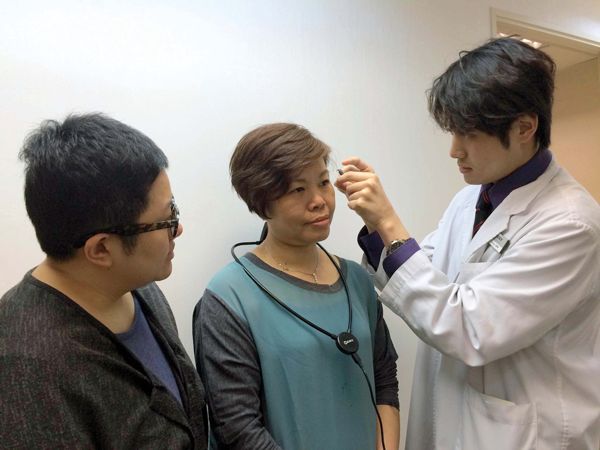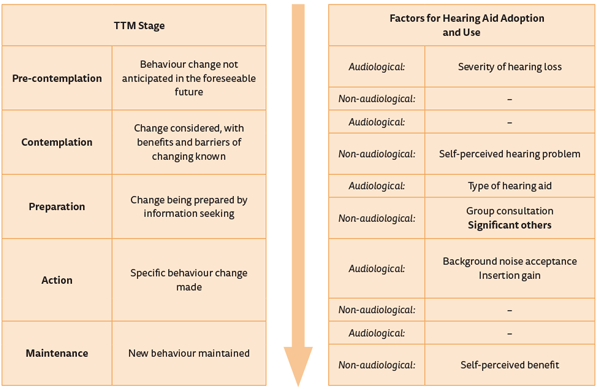Presbycusis, or age-related hearing loss, is one of the most common conditions affecting older adults and its prevalence is found to increase with age. Over the years, amplification technology has advanced significantly from analogue to digital signal processing. Despite this, the rate of hearing aid adoption has not increased with such technological innovations. This leaves the audiology profession with a big question: what can be done to facilitate hearing aid adoption?
Impact of presbycusis
Hearing loss is the most prevalent sensory disability and is one of the greatest disease burdens globally. The World Health Organisation estimate that around 15% of the global adult population has a certain degree of hearing loss, and a quarter of them are aged over 65 years. Alongside the growth of the elderly population worldwide, it is projected that presbycusis will certainly develop into a public health issue with profound significance. Individuals with presbycusis inevitably experience exclusion from everyday communication, and the psychological and social consequences have been well documented in numerous studies. Recently, two prospective studies in the United States further discovered independent association between hearing loss and rapid cognitive decline as well as the incidence of dementia among older adults [1,2].
Hearing aids: why and why not?
While presbycusis is an irreversible impairment, amplification by means of hearing aids is one of the most common options for tackling hearing loss among older adults. In a systematic review, a task force of the American Academy of Audiology found that hearing aid use could reduce the psychological, social and emotional impact of sensorineural hearing loss, thereby improving individuals’ health-related quality of life [3]. Despite the documented benefits of hearing aid use, MarkeTrak surveys showed that hearing aid adoption among adults who are likely to benefit from amplification has remained at 20-25% in the past two decades [4]. As access to health care varies considerably across the globe, one would postulate that the rate of hearing aid adoption may be even lower in developing countries. Data from some demographic studies pointed out that hearing aid use among individuals with presbycusis in mainland China ranged from 1.1% to 16.52% [5]. The question is: can financial constraints alone adequately explain the low hearing aid adoption rate? The evidence would suggest not. A MarkeTrak study revealed that uniqueness of hearing loss, financial constraints, self-perceived need, attitudes towards hearing aids, knowledge, stigma, as well as recommendations and trust were simultaneously identified to be barriers to hearing aid adoption [4].
“Instead of the passive role of sharing the communication difficulties associated with hearing loss, significant others can play an active role in supporting individuals with presbycusis to develop their readiness for hearing aid adoption.”
Mattering to significant others
Communication is a process of information exchange between two or more individuals. The denial of hearing loss and the subsequent need for amplification among individuals with presbycusis could substantially affect the shared experience of communication. Qualitative research conducted by the Royal National Institute for Deaf People in the UK explored the impact of hearing loss on interpersonal relationships [6]. While couples reported changes in communication content and frustration associated with hearing loss, it was worth noticing that the sense of loneliness had been expressed more frequently among the hearing partners than the individuals with hearing loss. Furthermore, since the individual with hearing loss would feel incapable of joining some social events and couples typically undertook activities together, withdrawal from social interactions were found for both the individuals with hearing loss and their partners. The result of hearing aid use also demonstrated outcomes on significant others. An earlier study commissioned by the National Council on Aging in the United States revealed that, it was more likely for family members of elderly hearing aid users to report benefits in family relationships and feelings, instead of the users themselves [7].
Figure 1: Factors for hearing aid adoption and use across TTM stages. [8].
Significant others do matter
Traditionally, research on the success of hearing aid fitting focused on the individual’s hearing loss and the electroacoustic properties of hearing aids. A recent systematic review attempted to explore the clinical relevance of both the audiological and non-audiological factors influencing hearing aid adoption and use from the perspective of the Trans-theoretical Model (TTM) [8]. The study highlighted that an individual’s decision to adopt and use hearing aids involved a series of intentional changes across five stages. As shown in Figure 1, significant others appeared to be influential in preparing for the adoption of a hearing aid. This finding is of considerable implication. Instead of a passive role, sharing the communication difficulties associated with hearing loss, significant others can play an active role in supporting individuals with presbycusis to develop their readiness for hearing aid adoption.

Attending a hearing aid fitting appointment with a significant other.
The most recent MarkeTrak VIII survey in the United States found that the ‘spouse or relative’ posed great psycho-social influence among non-adopters with short-term (six months to one year) hearing aid purchase intent [9]. More than half (53%) of the individuals who had not acquired hearing aids would be motivated to adopt hearing aids if their ‘spouse or relative’ recommend them to. Data from EuroTrak I, the European equivalent to MarkeTrak, was shown to agree with the American findings [10]. Allowing for study methodology differences, advice from ‘spouse, relative, child, friend’ was found to be a key influencing factor for hearing aid purchase in France (41%), Germany (39%) and the UK (34%). To date, there has been minimal research into the specific role of significant others in hearing aid adoption. The influence of significant others through the TTM readiness continuum certainly requires further study.
References
1. Lin FR, Yaffe K, Xia J, et al. Hearing loss and cognitive decline in older adults. JAMA Internal Medicine 2013;173(4):293.
2. Gurgel RK, Ward PD, Schwartz S, Norton MC, Foster NL, Tschanz JT. Relationship of hearing loss and dementia: A prospective, population-based study. Otology & Neurotology 2014;35(5):775-71.
3. Chisolm TH, Johnson CE, Danhauer JL, et al. A systematic review of health-related quality of life and hearing aids: Final report of the american academy of audiology task force on the health-related quality of life benefits of amplification in adults. J Am Acad Audiol 2007;18(2):151-183.
4. Kochkin S. MarkeTrak VII: Obstacles to adult non‐user adoption of hearing aids. Hearing Journal 2007;60(4):24-51.
5. Jiang T, Ling Z. The present status of research on presbycusis and intervention in China. Chinese Journal of Ophthalmology and Otolaryngology 2007;7(1):9-13.
6. Echalier M. In it together. The impact of hearing loss on personal relationships. London, UK; RNID; 2010.
7. Seniors Research Group. The consequences of untreated hearing loss in older persons. Washington, DC, USA; The National Council on the Aging; 1999.
8. Ng JH, Loke AY. Determinants of hearing aid adoption and use among the elderly: A systematic review. Int J Audiol 2015 May;54(5):291-300.
9. Kochkin S. MarkeTrak VIII: The key influencing factors in hearing aid purchase intent. Hearing Review 2012;19(3):12-25.
10. Hougaard S, Ruf S. EuroTrak I: A consumer survey about hearing aids in Germany, France, and the UK. Hearing Review 2011;18(20):12-28.
Declaration of Competing Interests: Janet Ng is an employee of Widex Hong Kong, a subsidiary of Widex A/S.
SUMMARY
-
Despite the known benefits of hearing aid use, hearing aid adoption among adults who could benefit from amplification has remained low at 20-25% in the past two decades.
-
From recognising a hearing loss, to deciding to acquire a hearing aid and committing to continual use, hearing aid adoption involves a series of temporal changes instead of merely one single action.
-
Non-audiological factors and audiological factors are both clinically relevant in hearing aid adoption among individuals with presbycusis.
-
Emerging evidence revealed that significant others appeared to be influential in motivating individuals to adopt hearing aids.
-
Audiology practitioners could encourage individuals with hearing loss to attend an appointment accompanied by their significant others.





